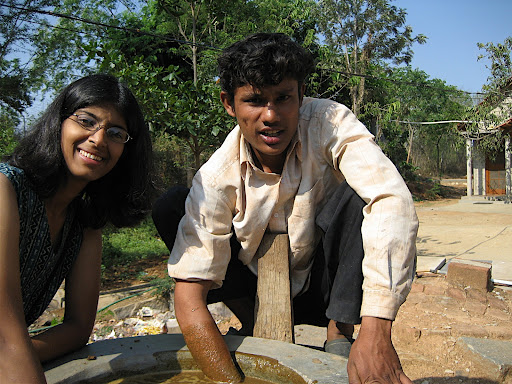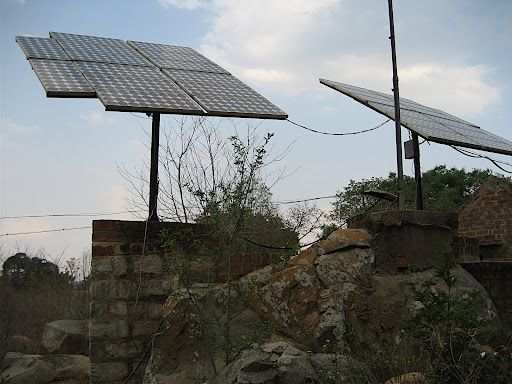Gobar Gas

They have about 20 heads of cattle now and their cowdung is used to run the gobar gas plant. Theirs has been functional for about 4 years and supplies the energy required for cooking. It is a fixed dome model (deenbandhu model) and the slurry drains off into one of two composting ponds. One of them was full and they would soon use it as manure.
They use about 65 kgs of cowdung everyday to create methane gas. I had no idea 20 heads of cattle produce that much, in fact more since they go grazing too, cowdung! Every morning at around 9, the people taking care of the cattle cart in the gobar and mix it in the tank with water. The dung needs to be mixed well. This is done manually and I also put my hand in. I was glad it didn’t feel dirty, though my hand had a distinctive gobar smell for the rest of the day, or maybe it was all in my head!
Solar energy

ND uses solar power for lighting, pumping water and for hot water. None of the buildings there have fans. They have been constructed in a manner that keeps them quite breezy and pleasant even in summer. Solar power is also used for the electric fence. They have had a bunch of panels for about 12 years now. They came with a10 year warranty and were supposed to work for 20 but they seem to be breaking down now. Om was a little disappointed with their performance given the high input costs and was talking about exploring more into using oil made from honge seeds for their energy needs.
Honge seeds
Oil extracted from honge seeds is used instead of diesel to provide energy. At ND, they run the generator on honge oil and it provides energy to the grinding machine that is part of their health foods unit. ND does not have many honge trees and they purchase the honge seeds from the nearby villages. The day I was leaving, the generator had broken down because the honge oil was too thick and had some drops of water. I am not sure if this is a regular feature or a one-off incident since I did not get a chance to talk to Om and Ananthu about it. These could be some problems associated with using honge oil.
Wind energy
ND currently has one windmill. It is a relatively new entrant into their experiments on alternate energy. Based on the wind velocity, it can generate up to 400W of power but on an average it produces about 150W. The power from this was used at Ananthu’s house for lighting, powering up a computer and an occasional use of a mixer. The entire unit cost about Rs 70,000 and was imported from China since India right now has good working models for commercial windmills but not for smaller ones like what they have installed. The investment seems to be high. I am not sure how this can be adopted extensively. Perhaps there are subsidies, I haven’t looked and didn’t ask Ananthu.
No comments:
Post a Comment